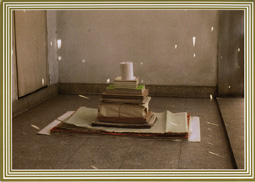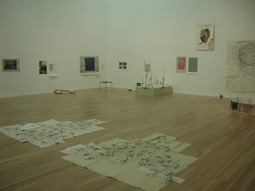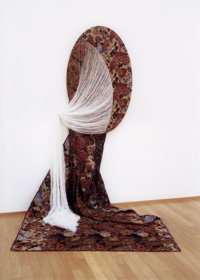 |
Focus features two in-depth reviews each month of fine art, architecture and design exhibitions and events at art museums, galleries and alternative spaces around Japan. The contributors are non-Japanese art critics living in Japan. |
|
|
 |
 |
 |
MOT Annual 2008: Unraveling and Revealing
Roger McDonald |
 |
The MOT Annual exhibition is an opportunity for the Museum of Contemporary Art Tokyo to survey significant issues in contemporary art from Japan in the public domain. It has occurred since 1999.
 |
 |
|
Fumio Tachibana, Q-Tai, 2005
|
|
|
|
 |
|
Fumio Tachibana, Kuchi, 2008
Collection of the artist
|
|
The 2008 exhibition title is "Tokihogusu Toki" (Unraveling and Revealing) and includes work by five artists: Aiko Tezuka, Teppei Kaneuji, Toshiaki Hicosaka, Mariko Takahashi and Fumio Tachibana. The curator, Mihoko Nishikawa, speaks about living in an age of abundant materiality and choice, and thus makes the case for taking time to acquaint ourselves with the minutiae of things in order to understand their nature and reality. This seems to be the exhibition's raison d'etre for "unraveling and revealing" through which we can encounter the world anew. No doubt for the artists, the complex processes they experience when making work are akin to those of unraveling and discovery. The studio is a place of experimentation (a sort of scientific lab, even), of probing and trying things out without the strictures of having to attain particular goals or quotas. This seems a significant point in the exhibition. Although modern scientific method has privileged processes of reduction in order to reveal "truths," artistic practice seems crucially embedded in different sets of processes, which undulate between language (categories) and what the philosopher Henri Bergson referred to as "elan vital," the flow of things. This exhibition asks us to look at the formal results of these processes. A healthy paradox thus underlines the curatorial premise.
 |
 |
|
Aiko Tezuka, Extracting Warp Thread to Create a New Quantity, 2003
SPIRAL/Wacoal Art Center
Photo © Kazuo Fukunaga
|
|
Aiko Tezuka's textile-based works seem to resonate most literally with the theme of the exhibition. Her early pieces are large pieces of fabric which have been carefully unraveled, exposing thread and empty space. Her recent works involve processes of painting, layering and machine weaving, using baroque-looking patterns taken from many sources. These tend to be highly styled, looking like backdrops for theatre sets. Although the nature of textile is one of combining elements through weaving and its potential for loosening, Tezuka's formal investigations seem to limit the alchemical (transformative/dual) power which textile possesses.
Teppei Kaneuji is known for his sculptural constructions made from everyday found objects. An adherent of contemporary assemblage art in the vein of such artists as Rei Naito and Sarah Sze, Kaneuji's constructions are well behaved in comparison. They do not threaten the viewer in any way, by their frailty or relation to space, and instead simply fill space as interesting visual clusters. His more successful works are a small series of brown stained paper wall collages and constructions called "Muddy Stream from a Mug," which use the random fractal-like stains and blots from tea and coffee to create dynamic, unstable landscapes.
The most accomplished artist is Fumio Tachibana, whose installation is like a temporary outing of aspects of his studio. His work comprises many minor adjustments of cheap materials, mostly paper. On the floor is an open book, made by the artist, standing so that it forms a gentle psychedelic circle. A bundle of rolled newspapers, tightly bound with string, stands on end on the floor. What makes Tachibana's work so interesting is its sense of curious and constant experimentation through processes of unraveling, etc., but also its ability to actually create something highly mysterious and secret at the same time. Much of the work looks simple, dirty and torn, even; yet each material has undergone some kind of transformative act that at once reveals it and discloses it as a web of connections within more unlimited processes. The interesting aspect in this is also to recognize Tachibana's materials as accumulations of his life, as those throwaway items such as newspapers, advertisements and print media that contribute to shaping our social and cultural selves. I was moved by how these highly impersonal, reproduced objects were re-invigorated by the imagination through acts of inquiry. The American author Don DeLillo wrote: "When you try to unravel something you've written, you belittle it in a way. It was created as a mystery." This sense of tension between processes of revealing and the sustaining of mystery served as a benchmark for me in looking at the exhibition. |
 |
 |
 |
Roger McDonald
Roger McDonald was born and brought up in Tokyo, educated in the UK, and returned to live in Japan in 2000 after completing his PhD. He has worked on the Yokohama Triennale 2001 as assistant curator, the Singapore Biennale 2006 as curator, and organised a number of exhibitions and projects independently. He is deputy director of the non-profit curatorial collective Arts Initiative Tokyo, and teaches at Musashino and Tama Art Universities. |
|
 |
|